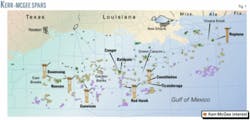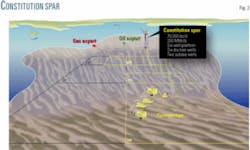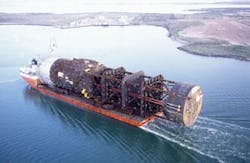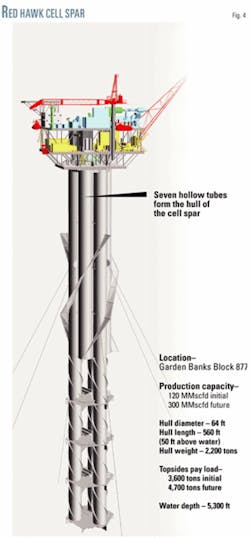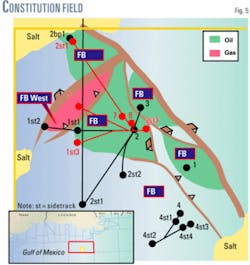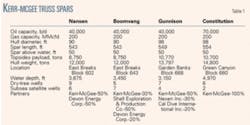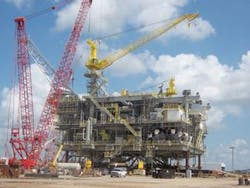In September, Kerr-McGee Corp. installed its sixth spar production facility in the Gulf of Mexico on Green Canyon Block 680. The Constitution spar, moored in 4,970 ft of water, initially will handle production from both the Constitution and Ticonderoga fields (Fig. 1).
As these fields decline, Kerr-McGee expects to tie other potential fields into the facility, in a hub-and-spoke development strategy. Its first five spars process fluids from more than 20 subsea tiebacks.
Subsea tiebacks connect new discoveries to existing production facilities, improving the economics of offshore oil and gas production so that marginal fields become profitable assets and existing production facilities have longer lives.
Initially, six dry-tree wells will produce the Constitution field while two subsea-completed wells will produce the Ticonderoga field (Fig. 2). The company expects first production from the development in mid-2006 and says the spar hull and topsides sustained no damage from Hurricanes Katrina and Rita.
Kerr-McGee holds a 100% working interest in Constitution and a 50% working interest in Ticonderoga. Noble Energy Inc. holds the remaining 50% working interest in Ticonderoga.
Spar technology
Oryx Energy Co. pioneered spar technology with production starting from its Neptune spar in 1997 (OGJ, Nov. 24, 1997, p. 72). Neptune is moored in 1,930 ft in Viosca Knoll Block 826 and handles production from 13 dry-tree wells and 5 subsea tie-ins including the subsea wells in the Nile field, which began production through Neptune in early 2005. Two additional tie-ins will come on line with the Swordfish development.
Since Kerr-McGee merged with Oryx in 1998, it has installed five more spars. But unlike the Neptune design, one of the five new spars has a cell design while the other four include a truss.
Neptune, often referred to as a “classic” design, is a large cylindrical hull moored in a vertical position. The truss spar, on the other hand, features an open truss that replaces the lower portion of the classic hull to reduce weight and cost of the structure (Fig. 3).
The third type of spar, the cell spar, has seven connected hollow tubes that form the hull (Fig. 4).
The Kerr-McGee spars are not designed to support a drilling rig. Drilling operations require that wells under the spar be drilled before installation of the spar. The spars also provide the option of being moved to the side to accommodate the drilling of wells beneath the spar with a drillship or semisubmersible drilling.
The spars can support a workover rig and at the end of the productive life of a field or area can be relocated to a new location.
Cell spar
Kerr-McGee deployed the cell spar in 2004 on the Red Hawk gas field in 5,300 ft of water.
It says the cell spar’s advantages are its ease of fabrication and flexibility and a more cost-efficient design that reduces the reserve threshold for economic development of deepwater fields.
One additional advantage is that the cell-spar hull tubes are constructed with standard rolling technology, allowing fabrication of the tubes in the US. The Red Hawk hull was built at the Gulf Marine Fabricators yard in Ingleside, near Corpus Christi, Tex. US fabrication reduces construction and transportation costs and time. A further cost reduction on Red Hawk was the use of polyester moorings and suction anchors.
Red Hawk has seven hollow tubes with a 20-ft diameter that provide both stability and buoyancy. Four of the seven tubes are 280 ft long, while the three others extend another 280 ft to the keel, or soft-tank section, which holds magnetite for ballast.
The Red Hawk topsides processing equipment can handle 120 MMcfd of gas and Kerr-McGee says the design has the flexibiltiy to be expanded to handle 300 MMscfd.
Two subsea completed wells produce the field. The cell spar does not have any dry-trees.
Truss spars
Kerr-McGee deployed its first two truss spars in 2002 on the Nansen and Boomvang fields in the Gulf of Mexico (Table 1). These spars are moored in 3,675 and 3,450 ft of water.
The truss spars have three key sections:
1. The hard tank for providing buoyancy to support the topsides.
2. The keel or soft tank for providing flotation during tow out and at the site providing a compartment for magnetite ballast once the spar is in a vertical position.
3. The truss to reduce the weight of the spar compared with the classic spar.
Nansen production is from East Breaks Blocks 602 and 646, while Boomvang produces from East Breaks Blocks 642, 643, and 688. The producing wells on each spar consist of nine dry-tree wells and six subsea wells on Nansen and five dry-tree wells and seven subsea wells on Boomvang.
Gunnison was Kerr-McGee’s third truss spar. It is moored in 3,150 ft of water and production started in December 2003. The facility has seven dry-tree wells and four active subsea wells in Gunnison field. Two additional subsea wells are under development, one in Gunnison field and the other at Dawson Deep. Production is from Garden Banks Blocks 667, 668, and 669.
Constitution development
Kerr-McGee initially based its Constitution spar design on the Gunnison spar, which has topsides capable of processing 40,000 bo/d and 200 MMcfd of gas. The similar design would reduce the time and cost for constructing the Constitution spar.
In 2004, the nearby discovery of the Ticonderoga field changed Kerr-McGees plans for the Constitution spar. To produce Ticonderoga earlier and not wait until Constitution field had declined from its plateau production, Kerr-McGee redesigned the topsides to accommodate the processing of 70,000 bo/d. The company said that it accomplished this redesign without having to change the base-case schedule for the start-up of production from the field.
The field is about 120 miles from the Louisiana coast, with Ticonderoga being 5 miles south of Constitution. Constitution was discovered in 2001 and Kerr-McGee delineated the field with 11 penetrations (Fig. 2).
The company describes the field as being in a salt minibasin with hydrocarbons trapped along the edges of a salt ridge. The field’s stacked Pliocene reservoirs are at a 12,000-15,000 ft depth. The initial well encountered more than 100 ft of net oil pay, and a second well had more than 350 ft of net oil pay.
Kerr-McGee says the reservoirs have good rock and fluid qualities that make them world class. The reservoirs have about a 28% porosity and more than an 800-md permeability. They produce a 32° gravity and 1.5-cp viscosity oil.
Kerr-McGee has identified seven different hydrocarbon zones in the field. One fault block in the field contains gas while the remaining fault blocks contain oil.
The area also has two additional exploration opportunities: Conquest and Covington.
Ticonderoga has two subsea completed wells producing to the Constitution spar through dual flowlines.
After the production is processed on the spar, the oil and gas enter Enterprise Products Partners LP pipelines.
A 70 mile, 14 and 16-in. pipeline transports the oil to the Ship Shoal 332B platform where the oil can enter two different oil pipeline systems to shore. The gas is exported through a 35 mile, 14 and 16-in. pipeline to a subsea interconnect on Green Canyon Block 241 for the Anaconda pipeline that connects the Marco Polo platform with a platform on Eugene Island Block 371.
One difference between the Constitution spar and the previous Kerr-McGee’s spars is the round keel tank. The Constitution spar needed the round tank so that it could be turned while at the dock at Ingleside to allow the addition of strakes on its other side.
Kerr-McGee indicated that because the spar is further east and south of the other spars, it can encounter more severe currents that can come from different directions. This more severe environment required strakes on both sides to prevent vortex-induced motions. The company’s other spars have strakes only on one side.
The spar was built in the Technip Offshore yard in Pori Finland and transported to the Gulf Marine Fabricators yard in Ingleside on the Mighty Servant 3.
Gulf Island Fabricators Inc. built the topsides in its Houma, La., yard (Fig. 6). ✦
